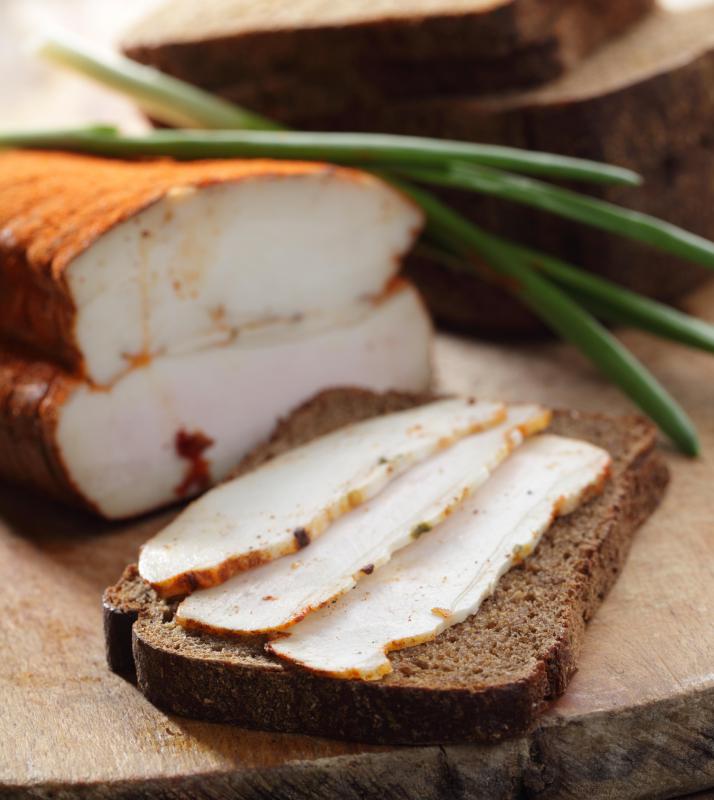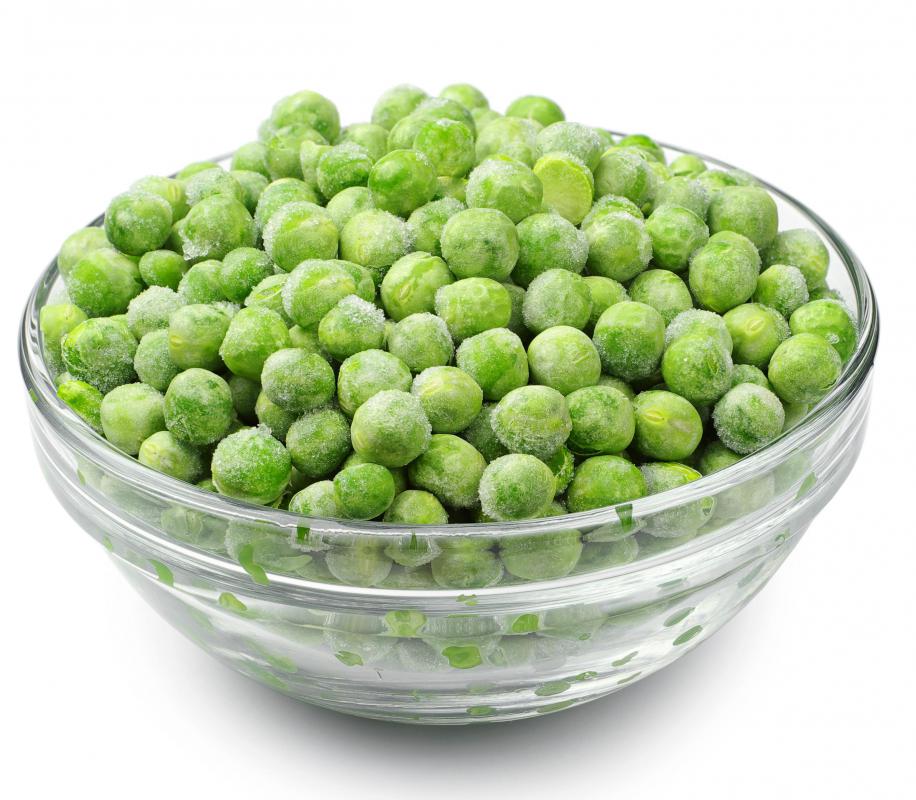At DelightedCooking, we're committed to delivering accurate, trustworthy information. Our expert-authored content is rigorously fact-checked and sourced from credible authorities. Discover how we uphold the highest standards in providing you with reliable knowledge.
What is Fatback?
Fatback is a cut of pork taken, as its name might suggest, from a pig’s back or spinal region. Most pigs do not use their back muscles very much, so this area is made up almost entirely of dense fatty tissue. Butchers carve the fat out into blocks or chunks that can be used as a food or cooking additive. It can be sliced and cooked as a sort of fatty bacon or fried up into crispy snacks; it can also be used as a lunch meat or flavorful addition to various meat and cheese platters. Cooks also frequently grind it up and add it to sausages, and it can be used as a cooking or frying fat as well.
Basic Composition

Butchers typically classify cuts of pork based first on where they are located, and second on the quality of the meat, which relates to how muscular or fatty it is. Fatback is a layer of subcutaneous fat that runs all along the animal’s spine, from its neck to its hind legs. This fat acts as insulation and protection, and as a result, it is much tougher than a lot of the comparably fatty cuts that can be found in the stomach or near the legs. These softer fats are used more as fuel for the muscles than for insulation and protection.

Back fat tends to be inexpensive since it contains little to no actual meat. Modern cooks prepare and use this fat in a range of ways, but the cut has been associated with the lower classes in the past. People who could not afford to buy more substantive pieces of ham could often more easily get fatback, and some butchers would give these cuts away if they didn’t discard them entirely.
Uses

Fat rendered from a pig’s back has a distinctive taste and texture and is considered by many to be a delicacy. Many people will slice and use it much as they would bacon, and the two cuts do have a lot in common. Bacon is typically a combination of meat and fat, however, while cuts from the back are usually pure fat. Pieces of fatback will crisp up much faster than bacon as a result, and they carry a distinctive crunchy texture that many people find appealing.

Back portions can also be slow simmered and used to flavor stews and vegetable dishes or ground to add substance and flavor to other meats, especially in sausage. The tissues can be thin-sliced and sold as a deli product or cooked down into lard that can be used for cooking and frying. How it is used is usually driven by local culture and regional culinary traditions.
Popularity in Southern Cooking

Soul food, which is popular in the U.S. South, makes liberal use of fatback, especially to add flavor to collard greens, beans, and stews. Like bacon, it can be used as barding, which involves wrapping the fat around other pieces of meat to give them more moisture during cooking. It can also be used as a preservative in a form of confit, where meat is immersed in the fat before it is stored. Some cooks cut the fat into strips and fry them, creating cracklings that are eaten as snacks.
Prevalence in Latin American Cuisine
A number of Latin American dishes, particularly those from the mountainous regions of Uruguay and Argentina, make liberal use of this cut as well. It is often seasoned and smoked or otherwise preserved, then stored for days or months at a time. This makes it portable and easily cooked on-the-go, where it can be added to peas, beans, and other dishes.
Uses in Europe
Cooks throughout Southern and Eastern Europe also treat fatback as something of a prized cut, often curing or seasoning it for use in delicatessens and on charcuterie (meat) platters. The tender taste and rich flavor makes it popular either on its own or paired with a variety of cheeses and hard breads. Italian chefs have long been known for using the drippings as a cooking oil for frying other foods, particularly meats and vegetables.
Where to Buy It
There is not always a big market for fatback, which means that not all butchers or delis carry it — or at least, they don’t always prominently display it. All pigs have this fat, however, so it can usually be ordered specially or set aside with a bit of advanced notice. A butcher who might ordinarily throw out the fatback can almost always save it if he or she knows that a customer is interested in buying it.
Confusion With Salt Pork
Many people confuse fatback with salt pork, a prepared meat product that is mostly fat, but which often contains some meat, too. There are more varieties of salt pork, as well; it can come from other parts of the pig, sometimes the sides or the stomach, and it is usually cured with salt and other spices. Some fatback preparations involve curing and seasoning, but the cut is usually sold raw and untreated.
Food Safety Concerns
Most health experts encourage chefs and home cooks to make sure that all meats and animal products are cooked thoroughly before being consumed. Some people make the argument that pure animal fat doesn't actually need to be cooked in order to be safe since it contains no meat, but this is not usually supported by food safety officials.
There are also health risks that come with eating large amounts of any highly fatty food. Most medical professionals recommend enjoying fats in moderation, ideally in conjunction with healthier foods, like fruits and vegetables. People who lead mostly sedentary lives and eat a lot of fats typically have a higher risk of heart problems, diabetes, and other health concerns.
AS FEATURED ON:
AS FEATURED ON:















Discussion Comments
Not being from the South, I am fascinated with Southern cooking, so I tried fatback and boy does it make green beans and collards taste amazing. I usually throw away the rind but an African-American friend looked at me in horror. She said I was throwing away the best part since it is fried crisp and munched on. Hmm. I think I'll pass on that.
Next time you make porgies, cut some salt cured fatback into 1/4x1/4 cubes. Fry slow on medium heat until browned and crisp. Place on a paper towel. After cooking porgies, place in a bowl and add some of the oil from pan and stir. When ready to serve add the cubes on top.
I understand how people needed to use all parts of the hog back in the day, but why do we subject ourselves to eating fatback now? Fat is just so gooey and gross. If I accidentally eat a piece of fat that is attached to the meat on my plate, I have to spit it out because it nauseates me.
I've never heard of eating fatback as bacon, but like bacon, it is used to flavor many vegetables. I live in the South, and many people here make green beans with fatback.
The fatback moistens them and gives them an awesome flavor. If you've ever tried green beans boiled plain and the ones boiled with fatback, you know that there is a huge difference, and most Southerners would not eat plain green beans because they are so bland in comparison to what they're used to eating.
I've also seen people use fatback to flavor butter beans and black-eyed peas. You absolutely have to eat cornbread with these veggies to get the full effect of the meal, and you can use the cornbread to soak up the extra flavored juices from the veggies, because you won't want to waste any of that fatback goodness.
My mother used to make collard greens with fatback in it and they were the best greens I ever had. I have still never had greens to rival hers.
I love fatback. I know some people that are kind of repulsed by it, but not me. I like it hot or clod, in sandwiches or plain. My wife buys it from this specialty butcher almost every week because I eat so much of it.
Does fatback expire? It has a suggested sale by date on it but since it is covered in salt, is it not cured? How long does it last in the fridge?
I am the son of Italian immigrants and my Nonna used to treasure the fat back. she would pound the dickens out of it with parsley and begin her sauce with a tablespoon of it. the rest would go back in the fridge. --stkf
No, it's not 1924 anymore. But fatback still tastes just as amazing!
It's not 1925 anymore. You don't have to eat fatback anymore.
I am 75 years old, and was raised in the south. We also salt cured fatback just as we did side meat, hams, and shoulders. We referred to "salt pork" as the belly fat. That (belly fat) is what we rendered down into "lard".
Post your comments